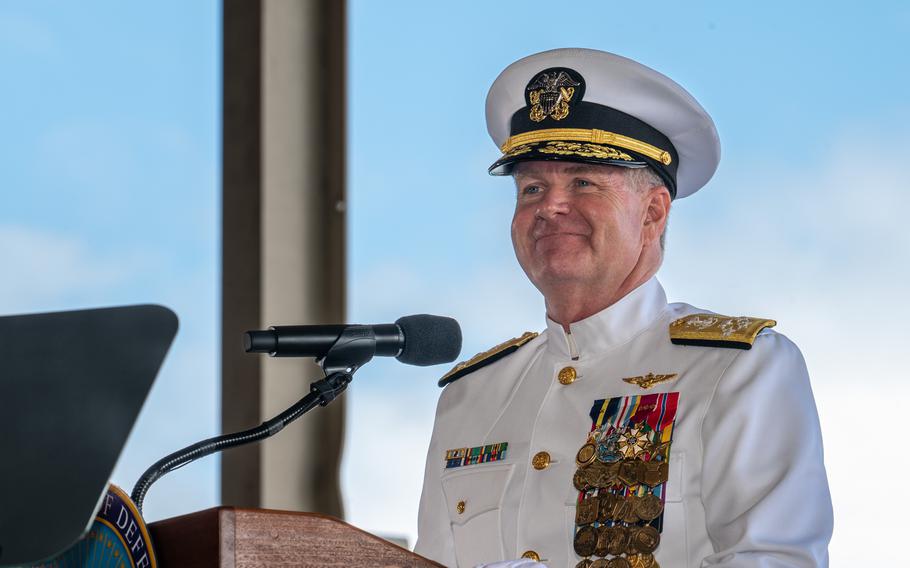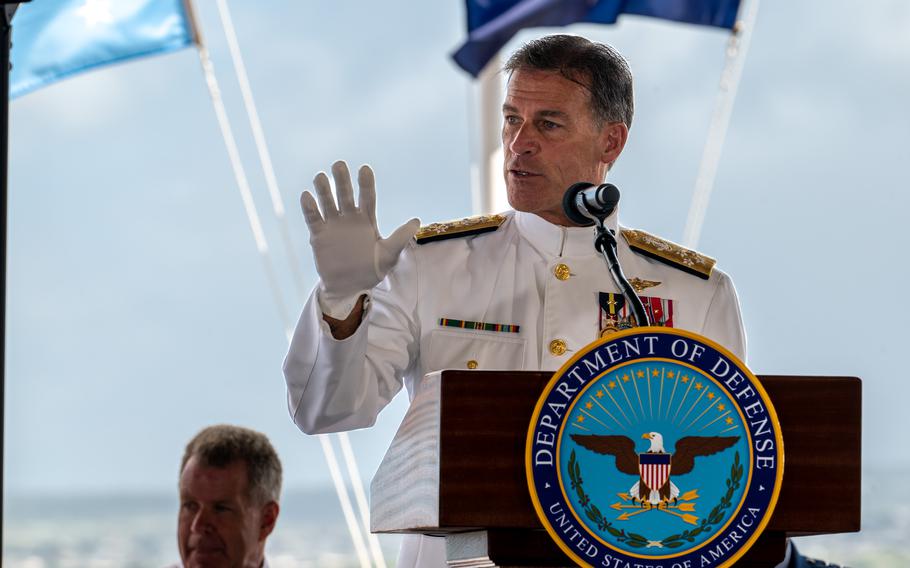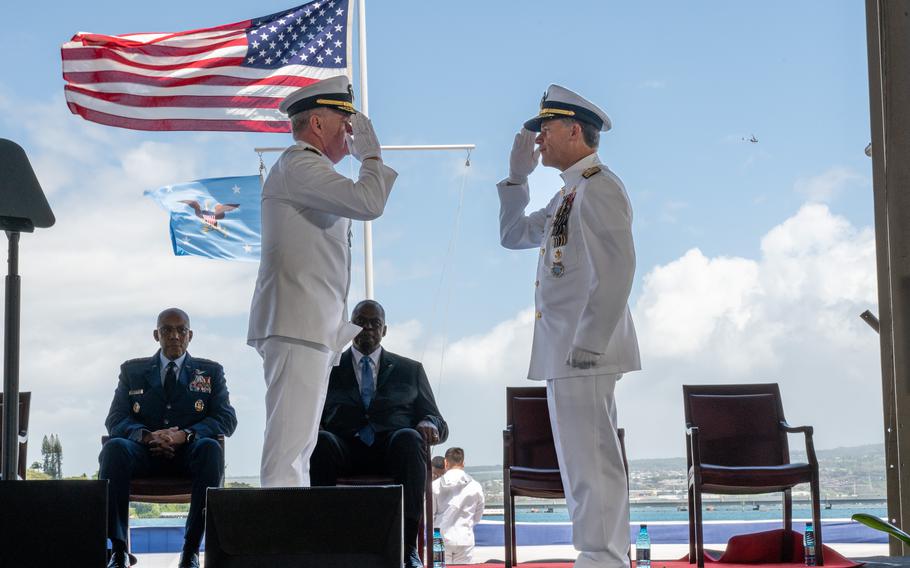
Adm. Samuel Paparo, commander of U.S. Indo-Pacific Command, delivers a speech during the change of command ceremony on Joint Base Pearl Harbor-Hickam, May 3, 2024. During the ceremony, Paparo assumed command from Adm. John Aquilino, who retired with 40 years of service in the Navy. (John Bellino/U.S. Navy)
JOINT BASE PEARL HARBOR-HICKAM, Hawaii — Flanked by the nation’s top defense officials, Adm. Samuel Paparo took the reins of U.S. Indo-Pacific Command during a ceremony Friday in Hawaii.
Paparo relieved Adm. John Aquilino, who is retiring after 40 years in the Navy.
Defense Secretary Lloyd Austin and Gen. Charles Brown Jr., chairman of the Joint Chiefs of Staff, took turns at the dais praising Aquilino’s tenure and welcoming Paparo, who most recently commanded U.S. Pacific Fleet.
“You know, we ask a lot of INDOPACOM these days, but every day over the past three years, this command has stepped up under the extraordinary leadership of Adm. Aquilino,” Austin told the audience at the joint base.
Aquilino had “helped transform our posture, strengthened our readiness and deepened our alliances and partnerships — and all of that bolstered our deterrence,” he said.
Austin lauded Aquilino’s oversight in moving toward greater cooperation with allies and partners in the region, his prioritization of an integrated missile-defense system for Guam and helping to distribute 130 million doses of COVID-19 vaccine in the region.
He also credited the admiral for his role in stationing the 12th Marine Littoral Regiment on Okinawa, Japan, and expanding U.S. access to four new sites in the Philippines under the Enhanced Defense Cooperation Agreement.
Austin arrived in Hawaii on Wednesday for meetings with his counterparts from Australia, Japan and the Philippines.

Adm. John Aquilino, commander of U.S. Indo-Pacific Command, delivers welcoming remarks during the change of command ceremony on Joint Base Pearl Harbor Hickam, May 3. During the ceremony, Adm. Samuel Paparo assumed command from Aquilino, who retired with 40 years of service in the Navy. (John Bellino/U.S. Navy)
Paparo now heads a combatant command that covers a vast area that includes 36 nations and just over half the world’s population.
Among INDOPACOM’s subordinate commands are U.S. Pacific Fleet, Marine Corps Forces Pacific, U.S. Army Pacific, Pacific Air Forces and Special Operations Command Pacific.
Paparo, a naval aviator, formerly commanded U.S. 5th Fleet and Naval Forces Central Command in Bahrain. He is a graduate of the Navy Fighter Weapons School and has flown the F-14 Tomcat, F-15 Eagle and F/A-18 Hornet fighter jets, among others, according to his official Navy biography.
Among his operational command tours at sea were Strike Fighter Squadron 195 at Yokosuka Naval Base, Japan; command of Carrier Air Wing 7, which was embarked in the Dwight D. Eisenhower Strike Group; and command of Carrier Strike Group 10.

Adm. John Aquilino, right, outgoing commander of U.S. Indo-Pacific Command, and Adm. Samuel Paparo, incoming commander of U.S. Indo-Pacific Command, exchange salutes during the change of command ceremony on Joint Base Pearl Harbor-Hickam, May 3, 2024. (John Bellino/U.S. Navy)
“Our world faces a complex problem set in the troubling actions of [China] and its rapid buildup of forces,” Paparo told the audience. “We must be ready to answer [China’s] increasingly intrusive and expansionist claims in the Indo-Pacific region.
“INDOPACOM, together with our partners, is positioned to deny and defend against attempts to break the peace accorded by the international rules-based order,” he continued. “The United States and our allies and our partners will uphold a stable and open international system that has been a pillar of global security and well-being for nearly a century.”
Paparo’s tenure as head of U.S. Pacific Fleet, which began in May 2021, coincided with the Red Hill fuel facility disaster that resulted in the contamination of the Navy’s drinking water system that served almost 100,000 people on and near the joint base.
An investigation ordered by Paparo concluded that a host of Navy deficiencies had led to the spill, including poor training and ineffective command and control.
In March 2022, Austin ordered the World War II-era fuel facility closed.
At Friday’s ceremony, Austin credited INDOPACOM for helping assure Red Hill was “safely defueled and transferred to the Navy for final closure.”